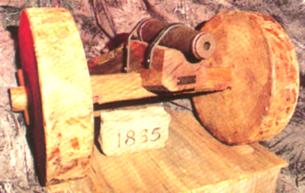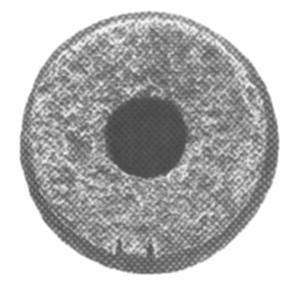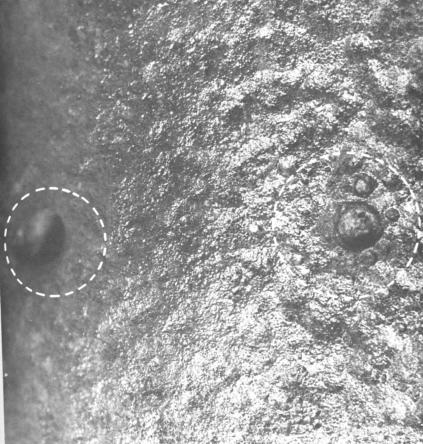SONS OF DEWITT COLONY TEXAS Fate of the Gonzales Cannon
Dr. Patrick Wagner, historian and gun collector, summarized his view in an article from The History of Gonzales County, Texas. In preparation for the confrontation at Gonzales he relates that "On October 1 John Sowell, Jacob Darst and Richard Chisholm exhumed the Peach Orchard Cannon and mounted it on the axle of Eli Mitchell's cotton wagon. Darst unspiked the touchhole leaving it somewhat oversized, about that of a man's thumb." He further describes his view of the fate of the cannon after the confrontation: "The following day, October 3, 1835, Noah Smithwick (see Evolution of a State, ch. VII), a skilled blacksmith and gunsmith arrived at Gonzales and received reports of the battle and noted how the wallowed-out touchhole had backfired smoke and powder during the battle. He took the rusty iron cannon back to Sowell's blacksmith shop to repair the touch-hole. He heated the weapon and poured molten metal in the oversized touch-hole. Hardening it with water, a crude nail bit was used to bore a new hole in the molten plug. That threw the ignition fire too far to the rear of the breech, so he spiked the new touch-hole with more molten metal. A second new touch-hole was then bored ahead of the first, but it was too small to sustain the fire powder with enough oxygen to discharge the cannon. The second touch-hole was plugged with molten metal and with plow-shearing and the point of a file, he center-punched the adjacent breech metal and the original spiked touch-hole. About fifteen degrees from the spike he bored a new and efficient touch-hole, brushed the cannon and mounted it on wooden trucks (wheels) cut from trunks of cottonwood trees found near the river bottom. To further magnify the cannon, a limber was attached to the trail of the cannon and the new carriage and limber were christened the 'Flying Artillery' it bounced out of Gonzales on October 12 enroute to Bejar." "According to Smithwick, about a day's march out of Gonzales, the axle and wheels began to smoke because of friction in spite of pouring water on it and using tallow as an axle lubricant. Two pair of longhorn steers had to be prodded with forty homemade file-pikes, which had been made by Chisholm and attached to cane poles. The file-pikes were the first and only uniform accouterments of the First Voluntary Army and their purpose was for use against the Mexican Cavalry. After the 'army' crossed Sandies Creek and went about one and one-half miles west they camped in a circular fashion around a mound on the west bank of the Sandies. On the morning of October 14, General Stephen F. Austin and Colonel Ben Milam inspected the broken carriage of the Flying Artillery, realized the ineffectiveness of the runty cannon and decided to abandon it. So, the cannon was buried in a shallow, sandy grave below its carriage which was set on fire to give the appearance of an Indian campfire. Creed Taylor reported that he last saw the cannon flag alongside a sapling near the cannon's grave."
In July, 1936 a flood unearthed a 21.5 inch long, 69 pound pitted and rusty iron cannon on the west side of Sandies Creek about 1.5 miles from where the old Gonzales-Bexar road crosses Sandies Creek on one of Byrd Lockhart's grants given for service as surveyor for the DeWitt Colony in western GonzalesCo. This location was consistent with where the volunteer army from Gonzales could have been when the cannon was abandoned as described by Smithwick and Taylor. The outer diameter of the muzzle was 3 7/16 inches, that of a six-pounder cannon of the period, but the inner bore was much too small. Wagner says "the 'Come and Take It Cannon' from its 101 year old resting place was spotted by rescue worker, Lowell Cooper. It was hot and he was standing knee-deep in mud at the time he spotted the cannon. He placed the cannon on higher ground near the road where a mail carrier saw it and took it to the old Gonzales Post Office. There it rested for about thirty two years. When the new Gonzales Post Office was built the unimpressive pipe-like tube was salvaged, taken to a gun exhibit in Houston where a Mexican gun collector [Henry Guerra] accepted it in a side trade for Indian artifacts. He had recognized it as a Mexican cannon of' early 19th century vintage. After keeping it in the gun room of his home in Reynosa for five years, he shipped it to the National Rifle Association display in San Antonio, Texas in May, 1979." There a Shiner gun collector, Wagner, spotted the unimpressive cannon, acquired it and with the help of two fellow researchers, Douglas Kubicek and Allan Ondrusek, spent two years researching the cannon and its history. Wagner argued that such a small cannon, pipe if you will, with some characteristics (outer diameter and oversize cascabel about the size of a 6# ball) of a conventional six-pounder which weighs much more would only take a few men to transport it, bury it, dig it up, be quickly mounted, transported quickly across creeks and rivers by non-professional volunteers as described for the Gonzales cannon. He cites stories from Gonzales families, Kellogg and Dikes, that have been passed down through the generations. One story refers to "the little black cannon" and another tells stories of the repeated submersion of the piece in the river to cool it off between firings. Ben Highsmith as told to author A. J. Sowell and published in Early Settlers and Indian Fighters of Southwest Texas in 1900 said "the cannon in question was a small affair, had never been used by the settlers against an enemy and they had no balls to fit it..." His description seems to describe a cannon with a small or odd bore. He says "John Sowell, a gunsmith of Gonzales, hammered out a ball on his anvil to fit the cannon, and it was loaded at his shop." Highsmith refers to slugs prepared in Sowell's shop used at the battle and says the cannon was fired five times.
1. They confirmed what he saw on the cannonoscopy. It had been a spiked
cannon. [Photo above: The opening at left is the touchhole and the right circled region is proposed by Wagner to be the spiked and bushed touchhole with center punch holes and plowsharing. He points out that the large course flaky pitting on this view was consistent with exposure to heating relative to the other side which exhibited a much finer rust oxidation. This may have occurred in the Gonzales blacksmith shops and/or exposure of the top side to the fire built over its burial place as described by Taylor. The lesser degree of oxidation relative to cannons described by Darst below that were in the Guadalupe River a much shorter time was consistent with the burial of the above cannon in the earth, rather than a waterway.] Patrick concluded that "the amnestic cannon had its identity recalled and the long lost Gonzales Come and Take It Cannon of October 2, 1835 was returned to its rightful place in Texas history."
Texas history researcher Thomas Ricks Lindley's research and view is summarized in the Handbook of Texas Online (search "Gonzales cannon") and in the footnotes to his article in the Alamo Journal (official publication of the Alamo Society) entitled Alamo Artillery: Number, Type, Caliber and Concussion, no. 82, July 1992. It is said that Texas historian and author Stephen Hardin withdrew his piece on the Gonzales cannon for the Handbook when he learned of Lindley's research. Lindley contends "the Gonzales cannon was not discarded or buried on the Gonzales road to Bexar. It was the first gun that went to San Antonio and there is ample primary evidence to prove it." He concludes that the cannon employed in the confrontation at Gonzales was among the armaments present at the second disastrous battle for the fortress in March 1836. Lindley discounts the description of the Gonzales cannon by Noah Smithwick as "just two of his many tall tales," the second of the specific two tall tales being "Smithwick also claimed that he arrived at Gonzales on Oct. 3, 1835, with a Dr. Fields, who later served with Col. James W. Fannin, Jr. at Goliad. Acording to documents in the Joseph E. Field Audited Military Claims file in the Archives of the Texas State Library in Austin, Texas, 'Dr. Fields' was actually Dr. Joseph E. Field. Field's military discharge shows that he enlisted in the Texian army as an assistant surgeon on Oct. 1, 1835 at Gonzales." Lindley discredits the Creed Taylor version of the Gonzales cannon in James T. DeShields' Tall Men With Long Rifles on the grounds that "DeShields did not "set down" or write a majority of the book." [For background on the DeShields publication, see In Search of Creed Taylor by Charlie Yates] DeShields failed to explain how Dickinson got the 'green' cottonwood trucks to burn down to a 'pile of ashes.'" This refers to the passage from DeShields attributed to Creed Taylor: "Men were set to work on a gun carriage. They felled a large cottonwood tree in the river bottom, and sawed from its trunk four sections for as many wheels, these being about four inches thick and were strengthened by strips of timber nailed on transversely." It should be noted that Smithwick referred to the carriage of the cannon as "on old wooden trucks - transverse sections of trees with holes in the centers, into which were inserted wooden axles." Lindley quotes Alamo Defender James George's 1835 claim: "This is to certify that I demanded and received, unto the public service, for halling the Gonzales Cannon to San Antonio: one yoke of oxen and all necessary geering; belonging to James George and that said yoke of oxen is now so much cripled as to render it unfit for service. November 23, 1835, H. Neill, Capt." and reminiscences of Sion R. Bostick who said the cannon was transported to Bexar. He cites a footnote in Ethel Zivley Rather's De Witt's Colony in the Texas Historical Association Quarterly, VIII (Oct.1904), which quotes Alamo Defender Jacob Darst's son, David Sterling Hughes Darst: "Mr. Darst says that the cannon was taken to Béjar at this time, and that shortly after the capture of Béjar two four-pound copper cannon and one nine-pound iron cannon were sent to Gonzales by the Texan troops at Béjar." Lindley cites most strongly William T. Austin's "Account of the Campaign of 1835 by William T. Austin, Aid[e] to Gen. Stephen F. Austin & Gen. Ed Burleson," Texana, IV (Winter 1966), presumably similar to the account published by Guy Bryan in Comprehensive History of Texas, as "a very complete account of the Texian army's trip to Bexar from Gonzales. It contains no claims of the Gonzales gun being discarded on the Sandy Creek and shows that of Oct. 20, 1835, when the army arrived at Salado Creek, outside of Bexar, it was armed with two six-pounders." It should be noted that although none of these accounts refer to abandonment of the cannon as does the Smithwick and Taylor (via DeShields) accounts, none refer specifically to arrival of the cannon with the army at Bexar, although all agree the cannon was mobilized in Gonzales for the trip. Lindley emphasizes the multiple reports that refer to the Gonzales cannon as a bronze or brass four or six pounder stating "the Gonzales gun was not an iron cannon, as to the belief that the old Texians and Tejanos could not tell the difference between an iron gun and a bronze one, if anyone believes that, they might as well believe those who couldn't tell the difference between east and west." It should be noted that Wagner contended that the "cannon was bi-metallic....a poorly refined brass alloy core and iron plowshared around it as the outer shell. The cannon was both brass and iron." Elsewhere in his analysis, Wagner pointed out that the initial written description of the cannon as bronze, rather than the mixture revealed by x-ray, was between politician and empresario who had no actual contact with the piece. Wagner points out that a four-pound cannon which was probably one of the copper cannons mentioned by D.S.H. Darst and thrown into the Guadalupe during the evacuation of Gonzales after the Alamo defeat was actually recovered by Darst in 1848 and was iron. He contends that this illustrates that non-ordinance oriented settlers in the period may have generally referred to cannon in the size range as brass four- or six-pounders without referring to details of their metal composition. From his study of Alamo ordinance in general, Lindley suggests that Smithwick may have worked on an iron six pounder belonging to George Huff which came from San Felipe via Harrisburg to Gonzales, and this became misidentified as the Gonzales cannon, although he believes this cannon also reached San Antonio and the Alamo. SONS OF DEWITT COLONY TEXAS |
 Like all
artifacts, documents, historic sources and views on Texas history, particularly those with
especially significant symbolic value, the fate of the Gonzales Cannon is a source of
controversy.
Like all
artifacts, documents, historic sources and views on Texas history, particularly those with
especially significant symbolic value, the fate of the Gonzales Cannon is a source of
controversy.
 [Photo: View of
Wagner's cannon from the muzzle. He believes the depressions and two hatched marks
at the bottom may be Smithwick's attempt to date his efforts as O 11 or Oct. 11]
The story of Dr. Wagner's efforts and research to prove the cannon recovered in
1936 was the cannon used in the battle which now resides in the Gonzales County Museum is
related in detail in the publication by Jane Bradfield, Rx, Take One Cannon: The
Gonzales Come & Take It Cannon. P.J. Wagner, Research & Publishing Co.,
Shiner, TX, 1981. By the use of
cannonoscopy as Wagner calls it, medical instruments for remote viewing were
employed to examine and photograph down the bore. He contends that it
revealed the spiking described by Noah Smithwick, the gunsmith. Later the
bushings were found via x-rays. He says that for all practical purposes,
Smithwick's signature and proofmark were recognized from his memoirs
published in 1900. Dr. Wagner concluded from the analysis that
"moulten metal was poured into the first big hole (the wallowed out touchhole).
When it cooled and hardened the blacksmith tried to redrill the touchhole to
the correct size. This failed and he moved forward to drill a second touchhole which
also failed. Both of these holes were plugged with a mixture of moulten metals which
suggested that the smithy didn't have enough of the original metal left. Then a
completely new touchhole was drilled."
[Photo: View of
Wagner's cannon from the muzzle. He believes the depressions and two hatched marks
at the bottom may be Smithwick's attempt to date his efforts as O 11 or Oct. 11]
The story of Dr. Wagner's efforts and research to prove the cannon recovered in
1936 was the cannon used in the battle which now resides in the Gonzales County Museum is
related in detail in the publication by Jane Bradfield, Rx, Take One Cannon: The
Gonzales Come & Take It Cannon. P.J. Wagner, Research & Publishing Co.,
Shiner, TX, 1981. By the use of
cannonoscopy as Wagner calls it, medical instruments for remote viewing were
employed to examine and photograph down the bore. He contends that it
revealed the spiking described by Noah Smithwick, the gunsmith. Later the
bushings were found via x-rays. He says that for all practical purposes,
Smithwick's signature and proofmark were recognized from his memoirs
published in 1900. Dr. Wagner concluded from the analysis that
"moulten metal was poured into the first big hole (the wallowed out touchhole).
When it cooled and hardened the blacksmith tried to redrill the touchhole to
the correct size. This failed and he moved forward to drill a second touchhole which
also failed. Both of these holes were plugged with a mixture of moulten metals which
suggested that the smithy didn't have enough of the original metal left. Then a
completely new touchhole was drilled."  Wagner listed
what he felt that the x-ray examination had revealed:
Wagner listed
what he felt that the x-ray examination had revealed: